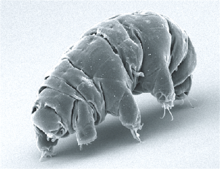
The list of tardigrades of South Africa is a list of species that form a part of the phylum Tardigrada of the fauna of South Africa. The list follows the SANBI listing.
Tardigrades (/ˈtɑːrdɪɡreɪdz/), known colloquially as water bears or moss piglets, are a phylum of eight-legged segmented micro-animals. They were first described by the German zoologist Johann August Ephraim Goeze in 1773, who called them Kleiner Wasserbär ("little water bear"). In 1777, the Italian biologist Lazzaro Spallanzani named them Tardigrada (/tɑːrˈdɪɡrədə/), which means "slow steppers".
They have been found in diverse regions of Earth's biosphere – mountaintops, the deep sea, tropical rainforests, and the Antarctic. Tardigrades are among the most resilient animals known, with individual species able to survive extreme conditions – such as exposure to extreme temperatures, extreme pressures (both high and low), air deprivation, radiation, dehydration, and starvation – that would quickly kill most other known forms of life. Tardigrades have survived exposure to outer space. There are about 1,300 known species in the phylum Tardigrada, a part of the superphylum Ecdysozoa consisting of animals that grow by ecdysis such as arthropods and nematodes. The earliest known true members of the group are known from Cretaceous (145 to 66 million years ago) amber, found in North America, but are essentially modern forms. Their origin is therefore likely much earlier, as they diverged from their closest relatives in the Cambrian over 500 million years ago.
Tardigrades are usually about 0.5 mm (0.020 in) long when fully grown. They are short and plump, with four pairs of legs, each ending in claws (usually four to eight) or suction disks. Tardigrades are prevalent in mosses and lichens and feed on plant cells, algae, and small invertebrates. When collected, they may be viewed under a low-power microscope, making them accessible to students and amateur scientists. (Full article...)
Where common names are given, they are not necessarily the only common names in use for the species.
YouTube Encyclopedic
-
1/5Views:4 936 6101 732 7824 538 1637 006 0796 675 245
-
The Rodent Tier List (Feat. RealLifeLore)
-
9 Animals That Are Extremely Difficult To Kill
-
Are Giraffes OP?
-
The Ice Age Tier List
-
The Insect Tier List
Transcription
Class Heterotardigrada
Order Echiniscoidea
Family Echiniscidae
Genus Echiniscus:[1]
- Echiniscus africanus Murray, 1907
- Echiniscus arctomys Ehrenberg, 1853
- Echiniscus crassispinosus Murray, 1907
- Echiniscus duboisi Richters, 1902
- Echiniscus longispinosus Murray, 1907
- Echlniscus perarmatus Murray, 1907
- Echiuiscus pusae Marcus, 1928
Genus Pseudechiniscus:[1]
- Pseudechiniscus bispinosus (Murray, 1907)
- Pseudechiniscus jiroveci Bartos, 1963
- Pseudechiniscus suillus Ehrenberg, 1853), syn. Echiniscus mutabilis Murray, 1905, Pseudechiniscus suillus suillus (Ehrenberg, 1853)
Class Eutardigrada
Order Parachela
Family Hypsibiidae
Genus Doryphoribius:[1]
- Doryphoribius flavus (Iharos, 1966), syn. Doryphoribius citrinus, (Maucci, 1972), Hypsibius citrinus Maucci, 1973
- Hypsibius convergens (Urbanowicz, 1925), syn. Macrobiotus convergens Urbanowicz, 1925
- Hypsibius dujardini (Doyère, 1840), syn. Hypsibius lacustris (Doyère, 1851), Macrobiotus dujardin Doyère, 1840, Macrobiotus dujardini Doyère, 1840, Macrobiotus samoanus Richters, 1908
- Hypsibius maculatus (Iharos, 1969)
Genus Isohypsibius:[1]
- Isohypsibius deconincki Pilato, 1971
- Isohypsibius nodosus (Murray, 1907), syn. Hypsibius nodosus (Murray, 1907), Macrobiotus nodosus Murray, 1907
- Isohypsibius sattleri (Richters, 1902), syn. Hypsibius bakonyiensis Iharos, 1964, Hypsibius sattleri (Richters, 1902), Isohypsibius bakonyiensis (Iharos, 1964), Macrobiotus sattleri Richters, 1902
Genus Ramazzottius:[1]
- Ramazzottius szeptycki (Dastych, 1980), syn. Hypsibius szeptycki Dastych, 1980, Ramazzottius szepticki (Dastych, 1980)
- Ramazzottius theroni Dastych, 1983
- Diphascon scoticum Murray, 1905, syn. Adropion scoticum Murray, 1905, Hypsibius scoticus (Murray, 1905)
- Diphascon zaniewi Kaczmarek & Michalczyk, 2004
Genus Paradiphascon:[1]
- Paradiphascon manningi Dastych, 1992
- Astatumen trinacriae (Arcidiacono, 1962), syn. Astatumen ramazzottii (Iharos, 1966), Itaquascon ramazzottii Iharos, 1966, Itaquascon trinacriae Arcidiacono, 1962
Family Calohypsibiidae
Genus Haplomacrobiotus:[1]
- Haplomacrobiotus seductor Pilato & Beasley, 1987
Family Macrobiotidae
Genus Calcarobiotus:[1]
- Calcarobiotus filmeri Dastych, 1993
- Calcarobiotus occultus Dastych, 1993
Genus Macrobiotus:[1]
- Macrobiotus drakensbergi Dastych, 1993
- Macrobiotus echinogenitus Richters, 1904
- Macrobiotus furciger Murray, 1906, syn. Macrobiotus furciger Murray, 1907
- Macrobiotus hufelandi C.A.S. Schultze, 1834, syn. Macrobiotus eminens Ehrenberg, 1895, Macrobiotus hufelandii C.A.S. Schultze, 1834, Macrobiotus interruptus Della Valle, 1914
- Macrobiotus nuragicus Pilato & Sperlinga, 1975
- Macrobiotus richtersi Murray, 1911
- Macrobiotus iharosi Pilato, Binda & Catanzaro, 1991
- Macrobiotus crassidens (Murray, 1907)
Genus Minibiotus:[1]
- Minibiotus hufelandioides (Murray, 1910), syn. Macrobiotus hufelandioides Murray, 1910
- Minibiotus intermedius (Plate, 1888), syn. Macrobiotus intermedius Plate, 1889, Macrobiotus intermedius intermedius]] Plate, 1889
Order Apochela
Family Milnesiidae
- Milnesium tardigradum Doyère, 1840, syn. Arcrophanes schlagintweitii Ehrenberg, 1859, Arctiscon tardigradum Schrank, 1803
